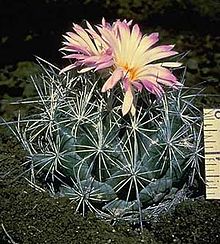- Coryphantha
-
Coryphantha 
Coryphantha ramillosa Scientific classification Kingdom: Plantae (unranked): Angiosperms (unranked): Eudicots (unranked): Core eudicots Order: Caryophyllales Family: Cactaceae Subfamily: Cactoideae Tribe: Cacteae Genus: Coryphantha
(Engelm.) Lem.Species - Coryphantha compacta
- Coryphantha difficilis
- Coryphantha echinus
- Coryphantha nickelsiae
- Coryphantha pycnacantha
- Coryphantha ramillosa
- Coryphantha robustispina
- Coryphantha salinensis
- Coryphantha sulcata
Coryphantha (from Greek, "flowering on the top") or Beehive cactus is a genus of small to middle-sized, globous to short-columnar cacti. The genus is found from Mexico to southern New Mexico and Texas in the United States. With its two subgenera, forty-three species and eleven subspecies, it is one of the largest genera of cactus.[1]
There are four characteristics that distinguish Coryphantha from other cacti.
- Their bodies do not have ribs, just tubercles.[2]
- The flowers form at the top of the plant (the apex or growing end of the stem).[1]
- The tip (podarium) of each flowering tubercle has three parts, the spiney areole, the groove and the axil. Without the groove it is not a Coryphantha.[1]
- The seed coat (or testa) has a net-like pattern (reticulate).[3]
More than many other cacti, the Coryphantha change in their appearance over their lifespan.[4] The presence or absence of a central spine is not indicative of the genus, even in fully adult plants.[4]
Contents
Name
The name Coryphantha for the group was first applied by Engelmann in 1856 as a subgenus,[5] the earlier name Aulacothele of Lemaire having been abandoned.[6] In 1868 Lemaire promoted the group to genus level.[5][6] Before this all Coryphantha had been classified as Mammillaria.
Synonymy
The genus has two vaild synonyms,
and three invalid ones.
- Aulacothele Monv. (nom. inval.),
- Glandulifera (Salm-Dyck) Fric(nom. inval.) and
- Roseia Fric (nom. inval.)
Related genera
A number of Coryphantha have previously been classified in other genera, indeed the type species C. sulcata was originally named Mammillaria sulcata[7] Other examples include Echinocactus salinensis Poselger 1853 now Coryphantha salinensis (Poselger) Dicht and A.Lüthy 1998[8] and Neolloydia pulleineana Blackberg 1948 now Coryphantha pulleineana (Blackberg) Glass 1968.[9]
Similarly, a number of other species have been previously classified as Coryphantha. For example, Escobaria vivipara was called Coryphantha vivipara.[10]
See also
- Mammillaria - a closely related cactus genus
Notes
- ^ a b c Dicht, Reto F. and Lüthy, Adrian D. (2005) Coryphantha: Cacti of Mexico and Southern USA Springer, Berlin, p. 1, ISBN 3-540-22306-1
- ^ Dicht, Reto F. and Lüthy, Adrian D. (2005) "3.2 Tubercles" Coryphantha: Cacti of Mexico and Southern USA Springer, Berlin, pp. 9-12, ISBN 3-540-22306-1
- ^ Dicht, Reto F. and Lüthy, Adrian D. (2005) "3.7 Seeds" Coryphantha: Cacti of Mexico and Southern USA Springer, Berlin, p. 17-20, ISBN 3-540-22306-1
- ^ a b Dicht, Reto F. and Lüthy, Adrian D. (2005) Coryphantha: Cacti of Mexico and Southern USA Springer, Berlin, p. 2, ISBN 3-540-22306-1
- ^ a b c d Anderson, Edward F. (2001) "Coryphantha" The Cactus Family Timber Press, Portland, Oregon, p. 186, ISBN 0-88192-498-9
- ^ a b Dicht, Reto F. and Lüthy, Adrian D. (2005) Coryphantha: Cacti of Mexico and Southern USA Springer, Berlin, p. 23, ISBN 3-540-22306-1
- ^ Britton, Nathaniel Lord and Brown, Addison (1913) An Illustrated Flora of the Northern United States, Canada and the British possessions, from Newfoundland to the parallel of the southern boundary of Virginia, and from the Atlantic Ocean westward to the 102d meridian (2nd edition) Scribner, New York, pp. 1-3, OCLC 852525
- ^ Dicht, Reto F. and Lüthy, Adrian D. (1998) "Im Feld wiederaufgefunden: Coryphantha salinensis (Poselger) Kakteen und andere Sukkulenten 49(11): pp. 256ff., in German
- ^ Glass, Charles (1968) "Cactaceas Mexicanas Poco conocidas" Cactaceas y Suculentas Mexicanas 2: pp. 34ff., in Spanish
- ^ Hunt, David R. and Benson, Lyman (1976) "The lectotype of Coryphantha" Cactus and Succulent Journal (U.S.) 48: pp.72ff.
External links
- "Gallery Images for Scientific Name = Coryphantha" PLANTS database, Natural Resources Conservation Service, United States Department of Agriculture
Categories:- Cacti
- Cacti of Mexico
- Cacti of the United States
- Flora of the Chihuahuan Desert
- Flora of Northwestern Mexico
- Flora of Northeastern Mexico
- Flora of New Mexico
- Flora of Texas
Wikimedia Foundation. 2010.
